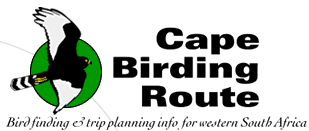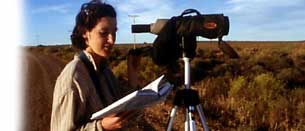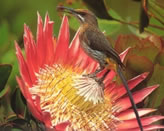De
Hoop Nature Reserve:
This reserve incorporates 36 000 hectares of lowland fynbos
and coastal dunes east of Cape Agulhas, including a low, fynbos-clad
mountain (Potberg) and a coastal lake. The cliffs on the southern
side of Potberg mountain are renowned for hosting the Western
Cape’s last breeding colony of Cape
Vulture (p.72*), while the coastal thickets of the lowlands
offer access to such desirable endemics as the Southern Tchagra
and Knysna
Woodpecker (p.72*).
From
Cape Town, De Hoop Nature Reserve is most easily reached by
taking the N2 national road as far as Caledon, where you turn
right onto the R316 to Bredasdorp. In Bredasdorp, turn left
(north) onto the R319, and turn right, 6 km later, onto the
signposted gravel road. The turn-off to the reserve entrance
(also signposted) is 30 km along this road (a particularly
good one for seeing Stanley’s
Bustard), and the reserve gate a another 6 km further
on. Allow at least three hours to reach the reserve from Cape
Town. An alternative route is via Swellendam, along the birding
loops described on p.64.
Access
to Potberg mountain is not, as one might expect, through the
reserve’s main entrance. Instead, continue along the
gravel road from Bredasdorp (see map, p.58), drive past the
turn-off to the main entrance, and follow the signs for about
10 km to the parking area and environmental centre below Potberg’s
southern slopes. The parking area is an excellent vantage
point from which to look for Cape
Vulture soaring over the nearby slopes, and a half-hour’s
scan overhead is bound to turn up birds wandering from the
colony just to the east.
The
eucalyptus (blue-gum) plantation and mixed alien and indigenous
thicket along the stream adjacent to the parking area hosts
a surprising number of interesting species. Knysna
Woodpecker occurs in the riverine strip of eucalyptus,
but is as unobtrusive and difficult to locate as ever (p.72*).
These alien trees have also hosted all three of the southwestern
Cape’s honeyguide species (Greater, Lesser
and Sharp-billed Honeyguide), along with a contingent
of forest raptors, including Black Sparrowhawk, African
Goshawk and Gymnogene. Swee Waxbill and
Southern Tchagra lurk in the thicket between the parking
area and the eucalyptus. Cape Siskin occasionally visit
from the mountain slopes above. The pleasant Klipspringer
Trail ascends to the summit of the Potberg (4 km each way),
offering some good fynbos birding (Cape
Rockjumper, Orange-breasted Sunbird, Cape
Siskin) in addition to guaranteed views of overflying
Cape Vultures.
The colony itself is not accessible to visitors, in order
to protect the breeding birds from disturbance. Hottentot
Buttonquail (see p.23) and Striped Flufftail
occur on the southern slopes of the mountain, but, as ever,
it is very difficult to see these ground dwellers.
De
Hoop’s main entrance gate is located on a range of limestone
hills, from which the road winds down onto the lowland fynbos-swathed
plains below. The fynbos is interspersed with open, pasture-like
areas, relics of efforts at agriculture prior to the proclamation
of the reserve. Chacma Baboon (Papio ursinus), Bontebok
(Damaliscus dorcas dorcas), Eland (Taurotragus oryx),
Cape Mountain Zebra (Equus zebra zebra), Angulate Tortoise
(Chersina angulata) and Ostrich favour these
pastures and are bound to be seen in good numbers in the vicinity
of the turn-off to the reserve headquarters and rest camp
(on the right, 4 km from the entrance). Capped Wheatear
and, peculiarly, Namaqua Sandgrouse also inhabit these
short-grass areas. The latter are likely to be heard calling
during mid-morning, as they fly over on their way to water.
In the open fynbos, look out for striding Secretarybird
and Southern
Black Korhaan, and quartering Black
Harrier (p.57*).
The
reserve office and rest camp are set among dense, gnarled
milkwood thickets adjacent to De Hoop Vlei. This large, irregularly
shaped lake can at times attract a huge number and an excellent
diversity of waterfowl and waders, although this varies greatly
between years and seasons. Great Crested Grebe is regular
here, and occasionally breeds in large numbers. Southern
Tchagra is shy but reasonably easy to find in the thickets
around the camping area – its call is loud and conspicuous
(De Hoop is one of the more westerly sites where it may be
found, although it occurs closest of all to Cape Town in Acacia
karroo thicket in the Karoo National Botanical Garden
at Worcester). Knysna
Woodpecker is surpris-ingly frequent around the vlei,
but is characteristically tricky to find (p.72*): look in
the thickets partitioning the camping sites. Common residents
of the vlei-side thicket are Bar-throated Apalis, Sombre
and Cape Bulbuls, Southern Boubou and, rarely,
Black Cuckooshrike. The area around the vlei and reserve
buildings is also one of the best places in the southwestern
Cape to see Pearl-breasted Swallow, which often feeds
alongside other hirundines such as White-throated Swallow
and Brown-throated Martin.
De
Hoop is one of the few places in the Western Cape where Horus
Swift is regularly seen, most often in the vicinity of
the vlei or flying low over the vegetated coastal dunes –
for instance, those around Koppie Alleen. The parking area
at Koppie Alleen (follow the signs on the main road from the
entrance gate) is at the eastern edge of a vast sand-sea of
pure white coastal dunes – a splendid place in which
to wander aimlessly and absorb the landscape. The rockier
coastline to the east of Koppie Alleen is frequented by good
numbers of African
Black Oystercatcher (p.32*), together with more widespread
coastal birds such as White-fronted Plover and a selection
of migrant waders including Sanderling, Turnstone
and Grey Plover. From July to November, many calving
Southern Right Whales (Eubalaena australis) make their
appearance along this stretch of coast and are easily seen.
|


